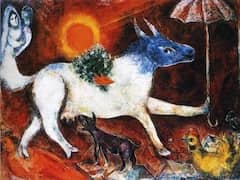To Russia, Asses, and Others, 1911 - by Marc Chagall

What strangely surrealistic dreams of a distant reality still alive in memory the picture surface can reflect is shown by this painting. It was one of the first pictures made in Chagall's new studio in La Ruche, which was big enough to allow him to make larger compositions than before. It must therefore have been painted at the beginning of 1912 - contrary to the date which was later inserted - but it goes back to a small watercolor of the previous year. Together with The Drunkard, it was exhibited at the Salon des Independants in March 1912.
This picture must have been regarded as an extremely strange and exotic intruder there. Indeed, it was unique among Trench paintings of that time, not only because of its content, which seemed so naively extravagant to French eyes, but also because of its magical color, radiantly emerging from a dark ground. Thus the critics of the day did not speak of Chagall as a richly inventive painter making pictures out of dreams and the unconscious - that was left to the Surrealists to discover.
The vision emerging from the picture plane is highly surprising. It unfolds in a sphere which is completely out of this world, where the rules of logic, gravity, probability, and normality do not count any more. Indeed, they are directly reversed and as a result reveal something wondrous yet natural and inevitable as in dream pictures. Looking like a messenger of the gods in her peacock robe, a milkmaid with a pail hurries through the magically illuminated heavenly zone down to a red cow which stands quietly feeding, while suckling a calf and a child, on the rooftops of a village. This bewildering contrast of the byre-warm country scene and the cosmic zone, irradiated by astral light prisms or mysteriously sinking into darkness, pushes the earthly things into a new kind of surrealistic dimension in which it does not seem unusual for a milkmaid to appear as a new constellation against the background of the night sky. It is precisely that inconsequence of circumstances, that constant interchange of reality and possibility with the improbable, which causes the chain of logic governing our concept of the outer world suddenly to break and makes the unreal appear as a poetic perception of reality - in this case as the poetic essence of a remembered reality. The contrast between the real and the unreal causes objective reality to appear as miraculous. The pictorial metaphor is created only by an inspired association of colored forms. This was the reason why the preparation of the picture plane as a field capable of supporting the images was of paramount importance. As for the contents and meaning of the picture, these were crystallized in the colored forms and could no longer be described in words by the painter.
















